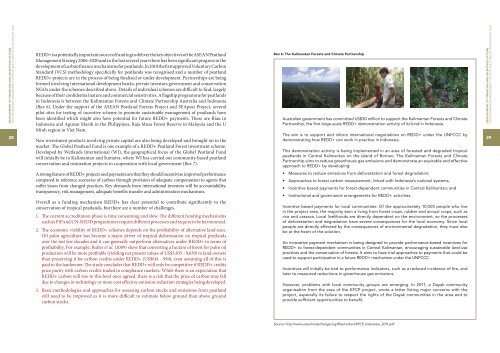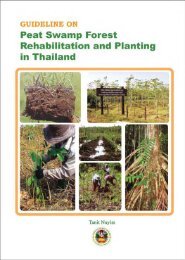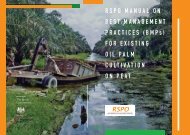Untitled - Peat Portal
Untitled - Peat Portal
Untitled - Peat Portal
Create successful ePaper yourself
Turn your PDF publications into a flip-book with our unique Google optimized e-Paper software.
DEVELOPMENT OF FINANCING AND INCENTIVES OPTIONSFOR SUSTAINABLE MANAGEMENT OF PEATLAND FORESTS IN SOUTHEAST ASIA28REDD+ is a potentially important source of funding to deliver the key objectives of the ASEAN <strong>Peat</strong>landManagement Strategy 2006-2020 and in the last several years there has been significant progress in thedevelopment of carbon finance mechanisms for peatlands. In 2010 the first approved Voluntary CarbonStandard (VCS) methodology specifically for peatlands was recognised and a number of peatlandREDD+ projects are in the process of being finalised or under development. Partnerships are beingformed involving international development banks, private investors government and conservationNGOs under the schemes described above. Details of individual schemes are difficult to find, largelybecause of their confidential nature and commercial sensitivities. A flagship programme for peatlandsin Indonesia is between the Kalimantan Forests and Climate Partnership Australia and Indonesia(Box 6). Under the support of the ASEAN <strong>Peat</strong>land Forests Project and SEApeat Project, severalpilot sites for testing of incentive scheme to promote sustainable management of peatlands havebeen identified which might also have potential for future REDD+ payments. These are Riau inIndonesia and Agusan Marsh in the Philippines, Raja Musa Forest Reserve in Malaysia and the UMinh region in Viet Nam.New investment products involving private capital are also being developed and brought on to themarket. The Global <strong>Peat</strong>land Fund is one example of a REDD+ <strong>Peat</strong>land Forest investment scheme.Developed by Wetlands International (WI), the geographical focus of the Global <strong>Peat</strong>land Fundwill initially be in Kalimantan and Sumatra, where WI has carried out community-based peatlandconservation and restoration projects in cooperation with local government (Box 7).Box 6: The Kalimantan Forests and Climate PartnershipAustralian government has committed US$30 million to support the Kalimantan Forests and ClimatePartnership, the first large-scale REDD+ demonstration activity of its kind in Indonesia.The aim is to support and inform international negotiations on REDD+ under the UNFccc bydemonstrating how REDD+ can work in practice in Indonesia.This demonstration activity is being implemented in an area of forested and degraded tropicalpeatlands in Central Kalimantan on the island of Borneo. The Kalimantan Forests and ClimatePartnership aims to reduce greenhouse gas emissions and demonstrate an equitable and effectiveapproach to REDD+ by developing:• Measures to reduce emissions from deforestation and forest degradation;• Approaches to forest carbon measurement, linked with Indonesia’s national systems;• Incentive based payments for forest-dependent communities in Central Kalimantan; and• Institutional and governance arrangements for REDD+ activities.DEVELOPMENT OF FINANCING AND INCENTIVES OPTIONSFOR SUSTAINABLE MANAGEMENT OF PEATLAND FORESTS IN SOUTHEAST ASIA29A strong feature of REDD+ projects and payments are that they should incentivise improved performancecompared to reference scenarios of carbon through provision of adequate compensation to agents thatsuffer losses from changed practices. Key demands from international investors will be accountability,transparency, risk management, adequate benefits transfer and administration mechanisms.Overall as a funding mechanism REDD+ has clear potential to contribute significantly to theconservation of tropical peatlands, but there are a number of challenges.1. The current accreditation phase is time consuming and slow. The different funding mechanismssuch as FIP and UN-REDD programmes require different processes and require to be harmonised.2. The economic viability of REDD+ schemes depends on the profitability of alternative land-uses.Oil palm agriculture has become a major driver of tropical deforestation on tropical peatlandsover the last few decades and it can generally outperform alternatives under REDD+ in terms ofprofitability. For example, Butler et al. (2009) show that converting a hectare of forest for palm oilproduction will be more profitable (yielding net present values of US$3,835 - 9,630) to land ownersthan preserving it for carbon credits under REDD+ (US$614 - 994), even assuming all of this ispaid to the landowner. The study concludes that REDD+ will only be competitive if REDD+ creditsprice parity with carbon credits traded in compliance markets. While there is an expectation thatREDD+ carbon will rise to this level once agreed, there is a risk that the price of carbon may falldue to changes in technology or more cost effective emission reduction strategies being developed.3. Basic methodologies and approaches for assessing carbon stocks and emissions from peatlandstill need to be improved as it is more difficult to estimate below ground than above groundcarbon stocks.Incentive based payments for local communities: Of the approximately 10,000 people who livein the project area, the majority earn a living from forest crops, rubber and annual crops, such asrice and cassava. Local livelihoods are directly dependent on the environment, so the processesof deforestation and degradation have severe consequences for the local economy. Since localpeople are directly affected by the consequences of environmental degradation, they must alsobe at the heart of the solution.An innovative payment mechanism is being designed to provide performance-based incentives forREDD+ to forest-dependent communities in Central Kalimantan, encouraging sustainable land-usepractices and the conservation of forests. It aims to have trial approaches to payments that could beused to support participation in a future REDD+ mechanism under the UNFccc.Incentives will initially be tied to performance indicators, such as a reduced incidence of fire, andlater to measured reductions in greenhouse gas emissions.However, problems with local community groups are emerging. In 2011, a Dayak communityorganisation from the area of the KFCP project, wrote a letter listing major concerns with theproject, especially its failure to respect the rights of the Dayak communities in the area and toprovide sufficient opportunities to benefit.Source: http://www.careclimatechange.org/files/carbon/KFCP_Indonesia_2011.pdf





